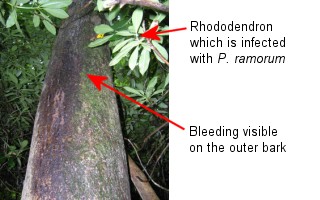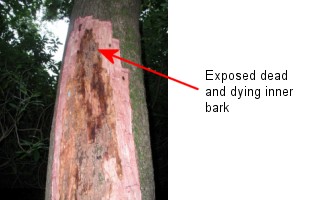Summary
Step 1: Determine the cause
A number of different agents can induce this condition and each has different management approaches.
It is essential to determine the cause of the bleeding in oak so that the correct management practices are applied.
Forest Research Tree Health Diagnostic Advisory Service (THDAS) can help diagnose the cause of bleeding, but there may be a charge for this service.
The following are tips on the kind of information that would assist THDAS:
- Survey and record the number of symptomatic trees and the severity of their condition.
- Record their distribution on the affected site.
- Take photographs of the trees so that a clear indication of the extent of damage on each tree is obtained. Close ups of symptoms are useful but the overall picture showing the condition of the canopy and stem is usually more informative and photographs taken over successive years allow changes in the condition of the trees to be analysed. If there are mushrooms associated with the stem base, branch wounds or on the ground around the roots, include pictures of these.
Step 2: Follow appropriate management treatment
Once you have a correct diagnosis of the cause of the bleeding, and if the condition is described as acute oak decline with symptoms of extensive stem bleeding, then follow the specific advice for the management of extensive stem bleeding on oak.
Advice on oaks and other trees affected by Phytophthora ramorum
Separate advice on the management of oaks and other trees affected by Phytophthora ramorum (often referred to in the USA as “Sudden Oak Death”) is given in:
“Phytophthora ramorum – A practical guide for established parks and gardens, amenity landscapes and woodland areas”.
This is available free from:
Defra Publications
Admail 6000
London SW1A 2XX
Tel: 08459 556000
or can be downloaded from the Defra website:
Bleeding on oak stems
About stem bleeding
Dark fluid oozing from bark and running down the tree trunk is a symptom referred to as stem bleeding or ‘bleeding canker’. It is most frequently caused by biotic agents, and in Britain a number of different pests and pathogens are known to induce this general symptom on oak. Occasionally abiotic causes such as drought stress can also be responsible for the bleeding. Although there are subtle differences in the position, severity and extent of bleeding which may enable the cause of the bleeding to be identified just by looking at it, this is not easy.
In general bark samples have to be taken from the affected tree so that the causal agent can be diagnosed in a laboratory by and expert.
Pathogens that can cause stem bleeding
Phytophthora is a well known pathogen able to cause stem bleeding on oak as well as many other tree species. For example in Britain, Phytophthora citricola, P. cinnamomi and P. cambivora attack various species of oak, mainly causing bleeding on the trunk up to 1 to 2 m above ground level. When diseased bleeding bark is pared away, in most cases the lesions are seen to link with root or tree collar infections.
More information on Phytophthora diseases of trees.
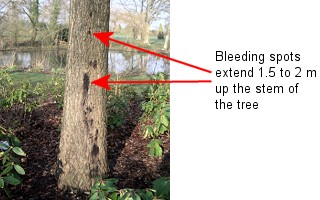
Turkey oak with stem bleeding caused by the soilborne pathogen Phytophthora cinnamomi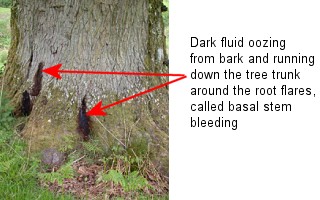
English oak with basal stem bleeding caused by Phytophthora citricola
Does Phytophthora ramorum cause stem bleeding?
Sometimes concern is expressed that Phytophthora ramorum (cause of Sudden Oak Death in the USA) could be causing stem bleeding on oak in Britain, but the likelihood of this is very low. P. ramorum has not yet been found on native English oak (Q. robur) in Britain although it has been found on a single sessile oak (Q. petraea) (see photos below) and a southern red oak (Q. falcata) in England. In continental Europe P. ramorum has infected a few red oaks (Q. rubra) causing bleeding stem cankers.
Generally native oaks in Britain are not susceptible to ‘Sudden Oak Death’. Also, for P. ramorum to attack oak (or any tree) locally it needs to build up on nearby rhododendron and cause heavy leaf infection from which many spores are produced. The spores then have to be wind or rain-blown onto the bark of nearby trees, before infection can occur through intact tree bark. An absence of heavily infected rhododendron almost certainly implies that bleeding on any tree is not caused by P. ramorum. Indeed most P. ramorum infected trees in Britain are only a few metres (5 to 10 m) away from the source of spores.
More information on P. ramorum and Phytophthora diseases of trees.
For more information on the management of P. ramorum or see the following publication:
Impacts of insects?
Buprestid beetles have also been associated with stem bleeding in mainland Europe. Similar symptoms occur in Britain and are currently being investigated in relation to Acute Oak Decline.
Ongoing investigations
Over the past two years there have been an increasing number of cases of oaks with prominent bleeding on their stems reported to us from locations in southern and central England. The symptoms are characteristic; longitudinal splits of about 8 to10 cm occur in the stem bark and a dark fluid (bleeding) often oozes profusely from these splits which occur all around the tree stem and extend high into the branches.
Forest Research scientists have been looking at a number of the affected trees in more detail over the last 5 months and it appears that the causal agent is not a Phytophthora (or other species of fungus) but bacteria. Over the next few months we hope to be able to provide more information about the identity of the agents, the extent of the damage caused, and whether this may be exacerbated by period of drought.
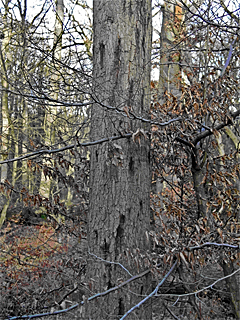
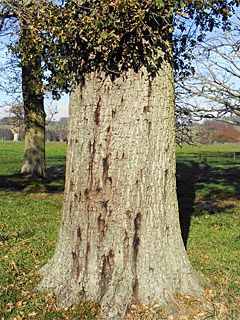
Recent examples of bleeding on woodland and parkland oaks possibly caused by bacteria
For more information on the management of extensive stem bleeding on oak.
Related materials

